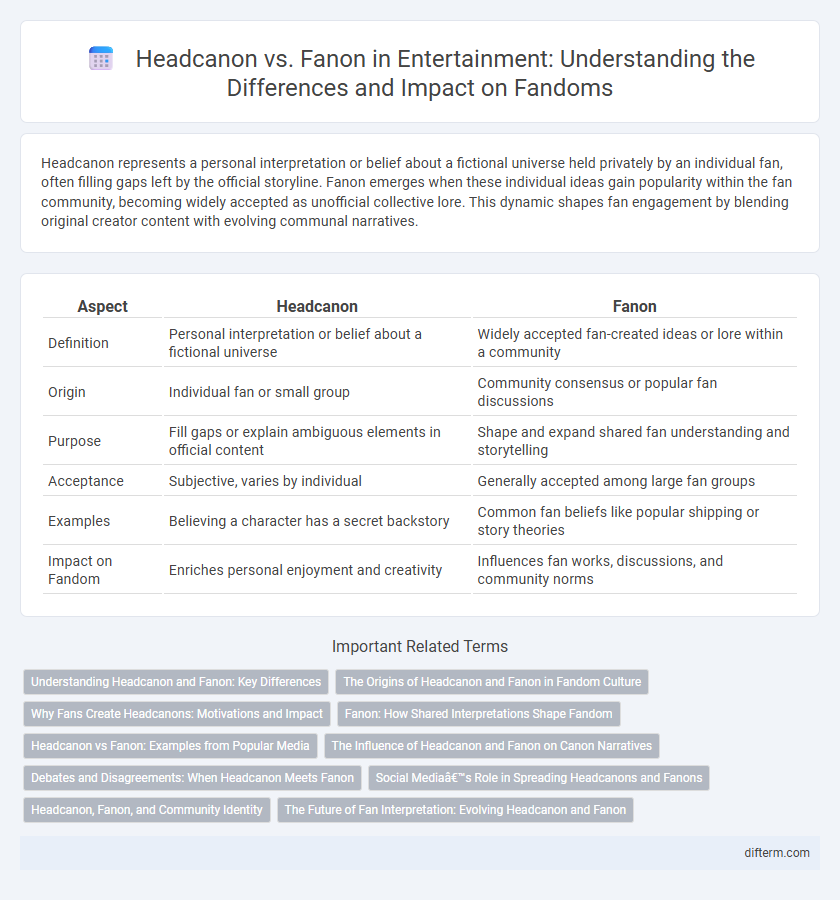Headcanon represents a personal interpretation or belief about a fictional universe held privately by an individual fan, often filling gaps left by the official storyline. Fanon emerges when these individual ideas gain popularity within the fan community, becoming widely accepted as unofficial collective lore. This dynamic shapes fan engagement by blending original creator content with evolving communal narratives.
Table of Comparison
| Aspect | Headcanon | Fanon |
|---|---|---|
| Definition | Personal interpretation or belief about a fictional universe | Widely accepted fan-created ideas or lore within a community |
| Origin | Individual fan or small group | Community consensus or popular fan discussions |
| Purpose | Fill gaps or explain ambiguous elements in official content | Shape and expand shared fan understanding and storytelling |
| Acceptance | Subjective, varies by individual | Generally accepted among large fan groups |
| Examples | Believing a character has a secret backstory | Common fan beliefs like popular shipping or story theories |
| Impact on Fandom | Enriches personal enjoyment and creativity | Influences fan works, discussions, and community norms |
Understanding Headcanon and Fanon: Key Differences
Headcanon refers to a personal interpretation or belief about a fictional universe that is not explicitly confirmed by the original creators, often shaping an individual's connection to the story. Fanon consists of ideas or elements widely accepted and embraced by a fan community, becoming almost as familiar as the official canon through collective acceptance. Understanding the distinction helps fans navigate their own imaginative contributions versus commonly shared interpretations within fandoms.
The Origins of Headcanon and Fanon in Fandom Culture
Headcanon originated as personal interpretations or imagined details fans privately attributed to characters or storylines, allowing individual creativity beyond official canon. Fanon emerged as shared fan-created ideas that gained collective acceptance within fandom communities, often influencing fan works and discussions. Both concepts shaped modern fandom culture by blending personal narrative expansion with communal storytelling dynamics.
Why Fans Create Headcanons: Motivations and Impact
Fans create headcanons to fill narrative gaps and personalize their connection with characters, enhancing engagement in fandom communities. These personal interpretations foster creative expression and enable fans to explore alternative storylines or character traits not present in official canon. The impact of headcanons extends to influencing fan works and discussions, shaping collective fan culture alongside widely accepted fanon elements.
Fanon: How Shared Interpretations Shape Fandom
Fanon represents collective fan-created interpretations that extend beyond official canon, creating a shared narrative within the fandom community. These consensual ideas influence character motivations, plot development, and world-building, enriching the fan experience through collaborative storytelling. Fanon enhances engagement by allowing diverse perspectives to coexist, fostering an evolving and interactive entertainment culture.
Headcanon vs Fanon: Examples from Popular Media
Headcanon and fanon both shape fan engagement by expanding fictional universes beyond official narratives. Headcanon refers to a personal interpretation or detail that a fan believes to be true, such as a fan imagining a character's backstory in Harry Potter, while fanon gains broader acceptance within the fandom, like the widely embraced idea of Loki as an anti-hero in Marvel comics. Popular media examples highlight the differences: headcanon remains individual and subjective, whereas fanon evolves into a collective understanding shared by many fans.
The Influence of Headcanon and Fanon on Canon Narratives
Headcanon and fanon significantly shape canon narratives by driving audience engagement and expanding character development beyond official storylines. These fan-generated interpretations often inspire creators to incorporate popular ideas into the official universe, bridging the gap between fandom and canon. The dynamic interaction between headcanon, fanon, and canon fosters a participatory culture that influences plot directions and character arcs in entertainment franchises.
Debates and Disagreements: When Headcanon Meets Fanon
Headcanon and fanon often spark intense debates within fandoms, as headcanon represents personal interpretations while fanon reflects collectively accepted ideas. Disagreements arise when individual headcanons challenge widely embraced fanon, prompting discussions about character motivations, plot developments, and universe rules. These conflicts highlight the dynamic nature of fandom culture, where personal creativity and communal consensus continuously intersect and evolve.
Social Media’s Role in Spreading Headcanons and Fanons
Social media platforms like Twitter, Tumblr, and Reddit play a crucial role in the rapid dissemination and popularization of headcanons and fanons within entertainment communities. These platforms enable fans to share, debate, and co-create interpretations of characters and storylines, leading to widespread acceptance and adaptation across diverse fanbases. The viral nature of social media accelerates the transformation of individual headcanons into collective fanon, shaping fan culture and influencing content creators.
Headcanon, Fanon, and Community Identity
Headcanon represents an individual fan's personal interpretation of a character or storyline not officially confirmed, while fanon emerges from collective agreement within the fan community, shaping shared narratives. Both concepts contribute to community identity by enabling fans to express creativity, debate meanings, and deepen emotional connections with the source material. The dynamic interplay between headcanon and fanon nurtures a collaborative culture where personal and communal interpretations coexist, strengthening fan engagement and loyalty.
The Future of Fan Interpretation: Evolving Headcanon and Fanon
Headcanon and fanon both shape the evolving landscape of fan interpretation, with headcanon representing personal beliefs fans integrate into a narrative, while fanon encompasses widely accepted interpretations within the community. The future of fan interpretation lies in the dynamic interplay between these concepts, driven by digital platforms that facilitate the rapid dissemination and validation of fan ideas. Advanced AI and collaborative storytelling tools further catalyze the transformation of individual headcanons into fanon, enriching the cultural fabric of entertainment fandoms.
Headcanon vs Fanon Infographic

 difterm.com
difterm.com